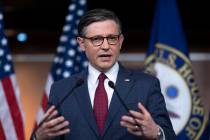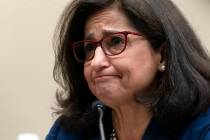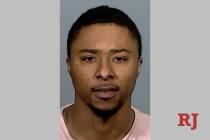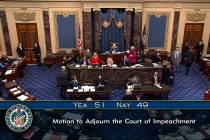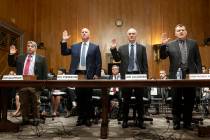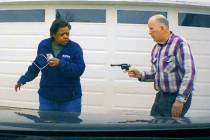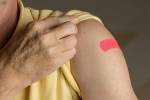Schools may be flu shot centers
WASHINGTON -- Hundreds of schools are heeding the government's call to set up flu-shot clinics this fall, preparing for what could be the most widespread school vaccinations since the days of polio.
A review of swine flu planning suggests there are nearly 3 million students in districts where officials want to offer the vaccine once federal health officials begin shipping it in mid-October.
Many more may get involved: The National School Boards Association said three-quarters of the districts in a recent survey agreed to allow vaccinations in school buildings.
After talks with state health officials, Nevada Superintendent of Public Instruction Keith Rheault said last week that mass inoculations might be made available to students on a voluntary basis. He said the shots "would be pretty wide scale, free of charge and possibly implemented at each school."
Plans are not yet finalized, Rheault said, "but it's the possibility, depending on the (case) numbers and what's happening across the country."
He said education and health officials worry that the virus could spread quickly when kids are back in school. "The fear is that (the virus) will mushroom and explode," Rheault said.
In South Carolina, "there will be a massive attempt to use schools as vaccination centers," said state Superintendent Jim Rex. He plans at least one vaccination clinic in each of the state's 85 school districts.
South Dakota started offering free children's vaccination against regular winter flu in 2007, and this year it plans to offer both kinds in many schools, said state Health Secretary Doneen Hollingsworth.
Now come the difficult details: figuring out all the logistics in giving squirmy youngsters a shot in the arm or a squirt in the nose.
That's in addition to measures being taken to keep the swine flu virus from spreading inside schools and to keep sick kids at home.
Already, Lee County, Miss., schools have reported a few cases of swine flu the first week of school, and a Louisiana high school football team reported 20 players sick or recovering from it.
To make sure students wash their hands, Minneapolis schools have outfitted every restroom with tamperproof soap dispensers, so students don't horse around with soap. And the district has a "no excuses" policy to keep them filled.
Bismarck, N.D., is insisting that parents keep feverish children home. "We're going to have to be a little firmer on that this year than in the past," superintendent Paul Johnson said.
It can be hard to tell if a child has a bad cold or flu, and swine flu and regular flu share the same symptoms. For many schools, a 100-degree temperature automatically means sending a child home.
The goal is to keep schools open; federal officials said last week schools should close only as a last resort. The emergence of the never-before-seen flu strain last spring prompted more than 700 schools to temporarily close, giving students an unexpected vacation as parents scrambled to find child care.
Some big states, like California, Ohio and Massachusetts, are focusing on those steps and not on vaccinations, because they don't know how much vaccine the federal government will send or when it will arrive. Boston has decided against in-school vaccinations because an attempt at regular winter flu inoculations at a middle school last year flopped, and Dallas officials also have decided against school shots.
But hundreds of districts are preparing for vaccinations. At least 700 health and school officials joined an online seminar last week by the National Association of County & City Health Officials on how to run school flu vaccinations.
The government is awaiting results of vaccine studies that began last week before making a final decision on whether and how to offer swine-flu inoculations. If vaccinations go forward, children are to be among the first in line. They could get vaccine at a variety of places, but federal officials want schools to play a starring role.
"The vaccine over time will be available to every child," Education Secretary Arne Duncan said. "And I personally think the best place for them to have access would be at their local school or at a school in their neighborhood."
An AP-GfK poll last month found parents like that convenience: Nearly two-thirds said they would probably give permission if their child's school offered vaccinations.
The school setting is attractive for many reasons, said Dr. Anne Schuchat of the Centers for Disease Control and Prevention.
Swine flu seems to strike the young most often, and it's particularly easy to spread from child to child. Moreover, school-age children "don't see doctors very often," Schuchat said, after they've accumulated the list of vaccinations required for school entry.
She added that it should be relatively easy for schools to offer flu-shot clinics because the federal government would be buying swine flu vaccine and sending it free to states.
There is plenty of experience with vaccinating school kids for regular flu, and there is plenty of evidence it works.
For the fourth year running, Knox County, Tenn., vaccinated 30,000 children for free in schools and day care centers last year. The county often closed schools because of winter flu outbreaks in the past, but it hasn't since vaccinations began.
And in the last flu pandemic, in 1968, Tecumseh, Mich., vaccinated 85 percent of its school-age children, resulting in two-thirds less illness there than in a neighboring community.
There is an important difference with this year's swine flu inoculations: Health officials think two separate doses, about three weeks apart, will be needed. Studies are under way now to confirm that. If so, it means any school that offers the first shot must set up for each recipient to get the second dose.
Different school districts handle vaccinations differently. Some will offer only vaccine against the regular winter flu, also important, as both types are expected to hit this year. In Florida's Pinellas County, which includes St. Petersburg, the health department won an economic stimulus grant to vaccinate every student at all 78 elementary schools against seasonal flu, said Rita Becchetti, supervisor of school health services.
That could be confusing for parents trying to remember which vaccine their child is getting.
Chicago, on the other hand, probably will have swine flu shot clinics at select high schools, not elementary schools, saying it simply doesn't have the workers to send teams to more than 600 schools.
Berkeley County, W.Va., is considering drive-through vaccinations at its three high schools, district official George Michael said.
In New York City, swine flu exploded in the spring at Saint Francis Preparatory School, which sent home 102 sick kids in one day. Today, City Health Commissioner Dr. Thomas Farley's first choice is for kids to get vaccinated by their own family doctors, but he's looking into clinics at schools or other locations.
"There's an awful lot of children who need to be vaccinated," Farley said.
Once the decision is made to offer flu shots at school, there are still issues to be worked out.
Not only must a parent sign a permission form, but someone needs to make sure it's filled out correctly and matches up with the kid. And there is staffing: Health professionals will need to administer shots and also check kids for reaction to the vaccine.
Schools will also need to decide whether parents should be present, said Brenda Greene, director of school health programs for the National School Boards Association.
"Are you going to do it at a time when the parents can be present, if they want?" Greene said. "I've heard the kids are more panicky when their parents are around than when they're not."
Knox County, Tenn., has always used FluMist, the nasal spray flu vaccine, to eliminate that concern, and will again this year in school vaccinations against regular flu. But most of the swine flu vaccine supply will be in shot form, and program director Jennifer Johnson hasn't decided whether to offer that in schools, too. She said one possibility is to inoculate kids at elementary schools after hours, so parents could hold scared youngsters and then be vaccinated themselves.
The nasal spray is popular. Last year, FluMist maker MedImmune said it sent about 450,000 doses of the nasal spray vaccine to 140 school vaccination programs. The company expects FluMist vaccinations against regular winter flu to nearly double in schools this year.
Duncan, the education secretary, understands the more immediate issue for many schools is the start of the new school year. Once kids are back in class, "you want to get parents focused on the vaccine," he said.
In St. Paul, Minn., vaccinations are on the back burner until school gets under way after Labor Day, said Ann Hoxie, assistant director of student health and wellness.
"It's not going to be the first thing on everybody's mind. Reading and writing remain at the top of the list," Hoxie said.
The Las Vegas Review-Journal contributed to this report.








